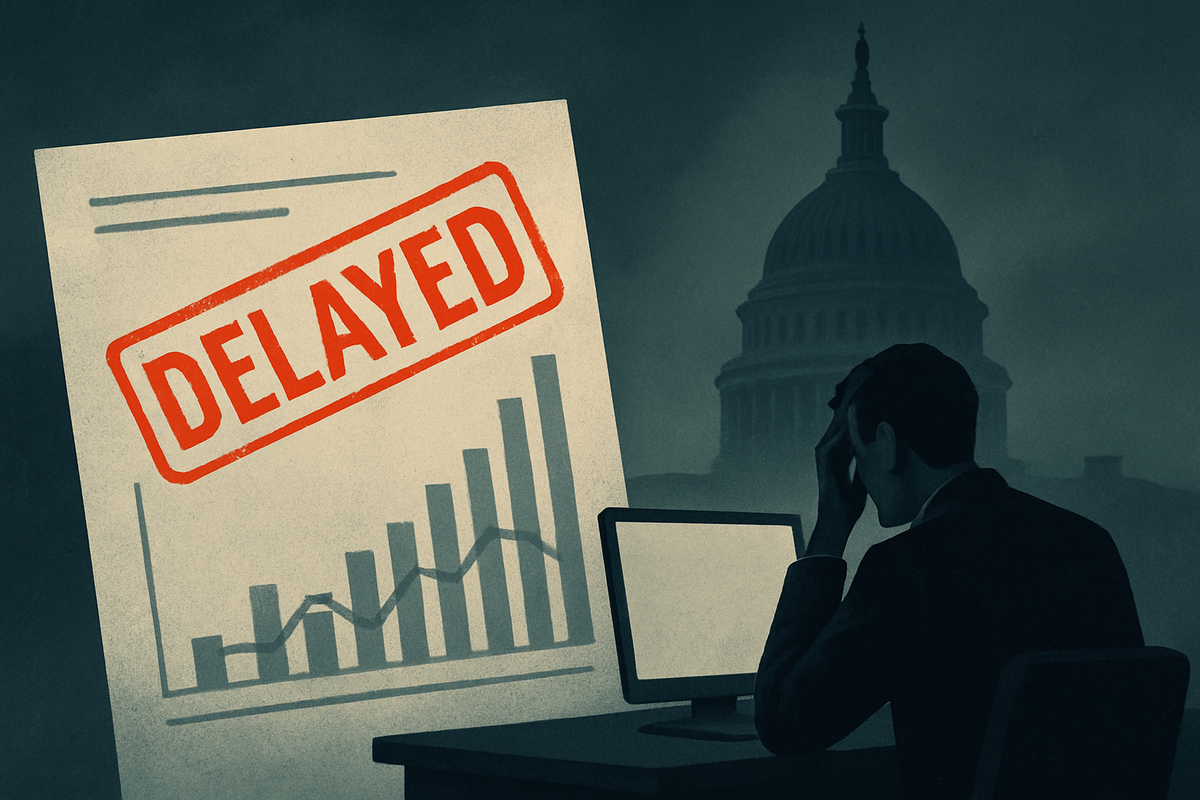
In a stark reminder of the fragility of economic intelligence, the United States once grappled with a government shutdown that significantly hampered the nation's ability to gauge its own economic health. Looking back from October 3, 2025, the October 2013 shutdown serves as a poignant historical case study, where the delay of the crucial September jobs report – the Employment Situation Summary – not only "muddied the view of hiring" but also left the Federal Reserve "flying blind" without essential economic data. This event underscored the profound impact political impasses can have on financial markets and the broader economy, illustrating how a lack of timely information can sow uncertainty and complicate critical policy decisions.
The 2013 shutdown, lasting 16 days from October 1 to October 17, stemmed from a congressional deadlock over funding for fiscal year 2014, primarily centered on disputes surrounding the Affordable Care Act. This political stalemate led to the furlough of hundreds of thousands of non-essential federal employees, effectively halting the operations of key statistical agencies. The immediate casualty was the September jobs report, originally slated for release on the first Friday of October. Its delay, alongside other vital indicators like weekly unemployment claims, inflation reports (Consumer Price Index), and third-quarter GDP figures, created an unprecedented data vacuum that left economists, businesses, and policymakers struggling to understand the true state of the labor market and the wider economy.
The Data Blackout: A Deep Dive into the 2013 Shutdown's Economic Disruption
The 2013 government shutdown was triggered by a profound disagreement between the Republican-led House of Representatives, which sought to delay or defund the Affordable Care Act, and the Democratic-led Senate and President Barack Obama, who opposed these efforts. When Congress failed to pass either an appropriations bill or a continuing resolution by the September 30 deadline, the federal government entered a partial shutdown on October 1, 2013. This legislative paralysis directly impacted the Bureau of Labor Statistics (BLS) and the Bureau of Economic Analysis (BEA), the primary custodians of the nation's economic data.
With many of their staff furloughed, these agencies ceased their data collection, processing, and reporting functions. The September jobs report, a critical barometer of the labor market, was already largely prepared, but its release was indefinitely postponed. This created immense uncertainty, particularly for the Federal Reserve's Federal Open Market Committee (FOMC), which was preparing for its late-October meeting. The Fed relies heavily on comprehensive and timely data to inform its monetary policy decisions, especially concerning interest rates and asset purchases. Without the official employment figures, the Fed's ability to accurately assess economic conditions and make informed choices was severely compromised, leading to concerns that it was "flying blind."
Initial market reactions to the 2013 shutdown were, surprisingly, somewhat muted. While such events typically herald increased volatility and a potential erosion of investor confidence, the S&P 500 (NYSE: SPY) even managed to reach a record high during the shutdown period. Analysts at the time attributed this relative calm to the fact that the 2013 impasse, unlike some other political confrontations, did not coincide with a federal debt-limit issue. The absence of a default threat, which would have significantly amplified market anxieties, allowed investors to largely "shrug off" the immediate impact of the data delays, although underlying concerns about economic visibility persisted. Key stakeholders involved included the U.S. Congress, the Executive Branch under President Obama, the BLS, BEA, Office of Management and Budget (OMB), and the Federal Reserve.
Corporate Crossroads: Who Gains and Who Loses in a Data Vacuum
In a climate of economic uncertainty fueled by delayed government data, various sectors and individual companies experience differing impacts. When the September jobs report was delayed in 2013, businesses across the spectrum had to contend with a fog of incomplete information, complicating their strategic planning and investment decisions.
Companies that are highly sensitive to economic cycles and rely heavily on precise labor market data for their forecasting and operational adjustments typically stand to lose the most. Retailers, for instance, such as Walmart (NYSE: WMT) or Target (NYSE: TGT), depend on robust employment figures and wage growth to predict consumer spending patterns, especially heading into crucial holiday seasons. A lack of this data makes inventory management and staffing decisions far more speculative. Similarly, manufacturing firms like General Motors (NYSE: GM) or Boeing (NYSE: BA), whose production schedules and capital expenditure plans are often tied to broader economic health, find their decision-making impaired. Small and medium-sized businesses, which often lack the sophisticated in-house economic analysis capabilities of larger corporations, are particularly vulnerable, as they struggle to adapt without clear signals from the market. Furthermore, companies reliant on government contracts, such as defense contractors like Lockheed Martin (NYSE: LMT) or IT service providers like Leidos (NYSE: LDOS), faced direct disruption due to the shutdown itself, with projects stalled and payments delayed.
Conversely, some companies might experience a relatively stable period or even indirect benefits. Firms in defensive sectors, such as utilities or consumer staples, tend to be less volatile during periods of economic uncertainty. Companies with strong balance sheets and diversified revenue streams are better positioned to weather the storm. Interestingly, the absence of official government data can create a niche opportunity for alternative data providers and economic consulting firms. Companies specializing in proprietary data analytics, such as those offering real-time payroll processing insights (e.g., ADP (NASDAQ: ADP)), or specialized economic research, might see increased demand as businesses and investors seek unofficial but timely indicators to fill the void left by government statistics. However, these alternative sources, while valuable, rarely offer the comprehensive scope and official validation of government reports, underscoring the indispensable role of agencies like the BLS.
The Wider Economic Ripple: Beyond Immediate Delays
The 2013 government shutdown and its associated data delays had wider significance that extended far beyond the immediate disruption. It highlighted a critical vulnerability in the modern, data-driven economy: the indispensable role of consistent, reliable government statistics for informed decision-making across all sectors. The "muddying the view of hiring" wasn't just an inconvenience; it represented a fundamental impediment to understanding a key pillar of economic health.
This event fit into broader industry trends emphasizing the increasing reliance on data for competitive advantage and strategic planning. Businesses, from small startups to multinational corporations, now integrate vast amounts of economic data into their algorithms for everything from supply chain optimization to marketing campaigns. When this foundational data stream is interrupted, it creates ripple effects that can impact consumer confidence, delay business investment, and even affect international perceptions of US economic stability. Competitors in other stable economies might gain a temporary advantage, while partners relying on US economic health for their own planning face increased uncertainty.
From a regulatory and policy perspective, the shutdown underscored the political risk inherent in the US system. It reignited debates about fiscal responsibility, the necessity of budget agreements, and the potential for future political impasses to weaponize essential government functions. Historically, while previous shutdowns have occurred, the 2013 event was particularly notable for its direct impact on crucial economic indicators at a time when the economy was still recovering from the Great Recession. Comparisons to other periods of economic uncertainty, such as the 2008 financial crisis, often emphasize the availability of data as a crucial difference. In 2013, the problem wasn't a lack of economic activity, but a lack of visibility into it, which, for the Federal Reserve, was akin to trying to navigate a ship through dense fog.
Navigating the Unknown: What Comes Next After a Data Blackout
The aftermath of the 2013 government shutdown offered crucial lessons on navigating economic uncertainty and the process of recovery once data streams resume. In the short term, once the government reopened, the delayed September jobs report was released relatively quickly, just three business days after federal employees returned to work. This immediate release helped to alleviate some of the acute uncertainty, providing the Federal Reserve with the data it needed to proceed with its FOMC meeting. However, the lag still meant that policy decisions were made with slightly older information than ideal, potentially leading to minor misalignments or delays in response.
In the long term, such events highlight the need for greater resilience in economic forecasting and strategic planning. Businesses and investors learned the importance of diversifying their data sources, incorporating alternative metrics and private-sector surveys to supplement official government statistics during periods of disruption. This could lead to continued growth in the market for alternative data providers. Future government shutdowns, especially if combined with a debt ceiling crisis, present a far more perilous scenario, potentially triggering severe market instability and a significant economic downturn. Such a confluence of events could force strategic pivots among companies, leading to re-evaluations of investment in the US or a greater emphasis on contingency planning for political risk.
Market opportunities might emerge for companies that can provide real-time or near real-time economic insights, or those that thrive on volatility. Challenges include maintaining investor confidence, managing supply chain disruptions, and making capital allocation decisions without clear economic signals. Potential scenarios range from quick resolutions with minimal lasting impact (as was largely the case in 2013 for the broader market) to prolonged stalemates that could severely undermine economic growth and investor trust. The key takeaway is that the political landscape can have direct and significant economic consequences, demanding vigilance from all market participants.
A Crucial Reminder: The Enduring Value of Economic Transparency
The 2013 government shutdown and the subsequent delay of the September jobs report serve as a powerful historical precedent, underscoring the critical role of timely and accurate government economic data in maintaining market stability and enabling informed decision-making. The episode vividly illustrated how the "muddying the view of hiring" and the Federal Reserve "flying blind" due to political impasses can inject profound uncertainty into the financial system. It was a stark reminder that beyond the immediate political rhetoric, the tangible impact of such events directly affects the mechanisms that drive economic growth and investor confidence.
Moving forward, the market must remain acutely aware of the potential for similar disruptions. While the 2013 shutdown's market reaction was relatively muted, largely due to the absence of a concurrent debt-ceiling crisis, future events could yield far more volatile outcomes. The lasting impact of such data blackouts lies in the erosion of trust and the increased difficulty in assessing fundamental economic health, which can lead to misallocated capital and suboptimal policy responses.
Investors should watch for signs of political gridlock, particularly in the lead-up to fiscal deadlines or debt-ceiling debates. The reliability and consistency of economic data releases are paramount. Any indication of potential delays should be a red flag, prompting a re-evaluation of portfolio exposures and a heightened focus on companies with strong fundamentals and resilience to economic shocks. The 2013 shutdown, though now in the past, continues to offer a vital lesson: economic transparency is not a luxury, but a necessity, and its disruption carries significant, far-reaching consequences for public companies, policymakers, and the broader economy.
This content is intended for informational purposes only and is not financial advice






